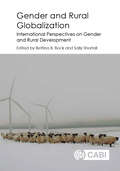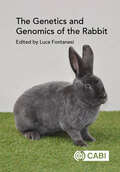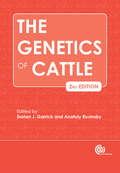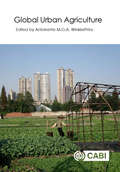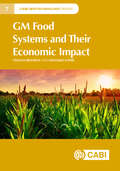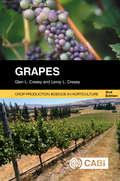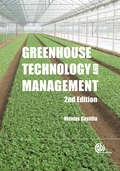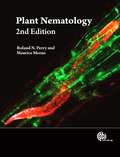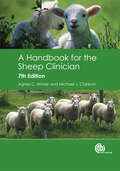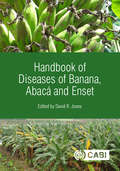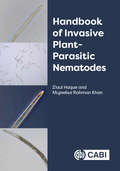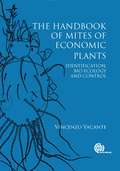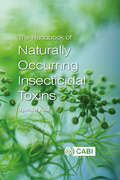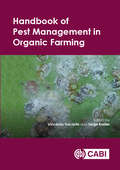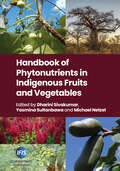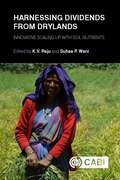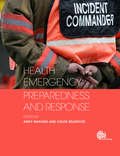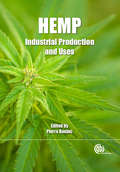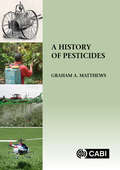- Table View
- List View
Gender and Rural Globalization: International Perspectives on Gender and Rural Development
by Monika Agarwal Margaret Alston Berit Brandth Angela Calvo Megan Canning Anne Cassidy Francesca Alice Centrone Majda Cernic Istenic Chrysanthi Charatsari Jessica Duncan Elisabeth Garner Donatella Greco Wendy Harcourt Marit S. Haugen Susie Jacobs Lori Ann McVay Ilona Matysiak Peter Mollinga Janet Momsen Angela Mosso Caoimhe Ni Dhonaill Nargiza Nizamedinkhodjayeva Mark Riley Carolyn Sachs Heather Sangster Sally Shortall Susanne Stenbacka Margreet van der Burg Chiara ZanettiThis book explores how rural gender relations are changing in a globalising world that fundamentally impacts on the structure of agricultural life in rural areas and urban-rural relations. It analyses the development of rural gender relations in specific places around the world and looks into the effects of the increasing connectivity and mobility of people across places. The themes covered are: gender and mobility, gender and agriculture, Gender and rural politics, rurality and Gender identity and women and international development. Each theme has an overview of the state of the art in that specific thematic area and integrates the case-studies that follow.
The Genetics and Genomics of the Rabbit
by Domenico Spina Cristiano Boiti Bernd Fischer Jianglin Fan Zsuzsanna Bosze Joana Abrantes Marielle Afanassieff Daniel Allain Andre Almeida Susana S. Araújo Manuel Baselga Agustin Blasco Paul Boettcher Gerard Bolet Darko Bosnakovski Samuel Boucher Samuele Bovo Gudrun A. Brockmann Luca Buttazzoni Cesare Castellini Pascale Chavatte-Palmer Peter Chrenek Veronique Duranthon Pedro José Esteves María-Luz García Hervé Garreau Elen Gócza Mélanie Gunia Pilar Hernández László Hiripi Arata Honda Adriana Kolesárová Ana Lemos de Matos Rose Mage Manolis Matzapetakis István Nagy Clive Page Mariana Palma Miriam Piles Andrea Rau Andreas Ritsch Claire Rogel-Gaillard Jun Pablo Sanchez Maria Antonia Santacreu Pierre Savatier Giuseppina Schiavo Ina Sternstein Zsolt Szendro Valerio Joe UtzeriRabbits have many uses - as well as being cherished pets, they are bred for their meat and fur, and as laboratory animals. Understanding their genetics and genomics is key to their production and, equally, to their care, welfare and health. Beginning with an introduction to the rabbit, including key information on their evolution, domestication and breed types, this book then concentrates on the genetics and genomics of this valuable animal. This book covers: - Cytogenetics, genetic maps and QTL mapping; - Immunogenetics; - Genetics of coat colour, meat, fibre and fur production, reproduction, disease resistance and more. Concluding with practical applications such as creating transgenic and genome edited rabbits, biotechnical applications and the rabbit as a biomedical model, this book brings this important topic fully up-to-date. It provides an indispensable resource for animal and veterinary researchers and students, as well as rabbit breeders and laboratory scientists.
The Genetics of Cattle 2nd edition
by Anatoly Ruvinsky Dorian GarrickSince the time of domestication more than 10,000 years ago, cattle have played an increasingly crucial role in the development of human civilizations. Progress has been quite remarkable since the turn of the century; the sequencing of the bovine genome in 2009 launched new avenues for furthering our understanding of theoretical and practical aspects of cattle genetics. Covering a vast array of questions, this book reviews major topics from molecular and developmental genetics, disease resistance and immunogenetics to genetic improvement of dairy and beef breeds, addressing all current problems in the field. This second edition includes a new team of authors and completely new chapters on the genetics of fat production, nutrition, feed intake and efficiency, growth and body composition. Fully updated throughout, it provides a valuable resource on cattle genetics for researchers, breeders, veterinarians and postgraduate students.
Global Urban Agriculture
by Antoinette M.G.A. WinklerPrinsThere has been growing attention paid to urban agriculture worldwide because of its role in making cities more environmentaly sustainable while also contributing to enhanced food access and social justice. This edited volume brings together current research and case studies concerning urban agriculture from both the Global North and the Global South. Its objective is to help bridge the long-standing divide between discussion of urban agriculture in the Global North and the Global South and to demonstrate that today there are greater areas of overlap than there are differences both theoretically and substantively, and that research in either area can help inform research in the other. The book covers the nature of urban agriculture and how it supports livelihoods, provides ecosystem services, and community development. It also considers urban agriculture and social capital, networks, and agro-biodiversity conservation. Concepts such as sustainability, resilience, adaptation and community, and the value of urban agriculture as a recreational resource are explored. It also examines, quite fundamentally, why people farm in the city and how urban agriculture can contribute to more sustainable cities in both the Global North and the Global South. Key Features: #65533; One of the first volumes to bring together evidence from urban agriculture in the Global North and the Global South #65533; Explores the contribution of urban agriculture to livelihoods, ecosystems and conservation #65533; Numerous case studies examine a very diverse range of urban agriculture systems
Global Urban Agriculture: Convergence Of Theory And Practice Between North And South
by Susan Algert ms Imogen Bellwood-Howard Fernando J. Bosco Sasha Broadstone Christian Brannstrom Jason A. Byrne James B. Campbell Joana Chan Brian W. Conz ms Lucy Diekmann Lauren Dryburgh Bryce B. DuBois Charles A. Francis Courtney M. Gallaher Leslie Gray Daniela A. Guitart Sophia E. Hagolani-Albov, Sarah J. Halvorson Michael W. Hamm Colleen Hammelman Kyle D. Hoagland Sarah S. Horowitz Pascale Joassart-Marcelli Sara Law Timothy F. LeDoux Juanjuan Liu Jonathan T. Lowell Nathan McClintock Leslie McLees Never Mujere Kristine T. Nemec Tammy E. Parece Catherine M Pickering Rebecca Sims-Castley Stephanie A. WhiteThere has been growing attention paid to urban agriculture worldwide because of its role in making cities more environmentaly sustainable while also contributing to enhanced food access and social justice. This edited volume brings together current research and case studies concerning urban agriculture from both the Global North and the Global South. Its objective is to help bridge the long-standing divide between discussion of urban agriculture in the Global North and the Global South and to demonstrate that today there are greater areas of overlap than there are differences both theoretically and substantively, and that research in either area can help inform research in the other. The book covers the nature of urban agriculture and how it supports livelihoods, provides ecosystem services, and community development. It also considers urban agriculture and social capital, networks, and agro-biodiversity conservation. Concepts such as sustainability, resilience, adaptation and community, and the value of urban agriculture as a recreational resource are explored. It also examines, quite fundamentally, why people farm in the city and how urban agriculture can contribute to more sustainable cities in both the Global North and the Global South. Key Features: · One of the first volumes to bring together evidence from urban agriculture in the Global North and the Global South · Explores the contribution of urban agriculture to livelihoods, ecosystems and conservation · Numerous case studies examine a very diverse range of urban agriculture systems
GM Food Systems and Their Economic Impact (CABI Biotechnology Series)
by Dr Tatjana Brankov Dr Koviljko LovreThe development of transgenic crops is revolutionary, but what does it mean for food production, prices and the environment? This is the first book to examine the economic evidence in a methodical way. It initially describes the historical evolution of biotechnology and defines key terms, before moving on to explore transgenic technology and food regime concepts. The book analyzes genetically modified organism (GMO) policy as part of overall agrarian policy, considering neoregulation in the USA, the EU, Brazil, Russia, China, India, South Africa and Serbia; as well as discussing agricultural performance, support and trade relations. The effect of transgenic food production on world food prices is also examined, along with food security at global and regional levels, and the links between GMOs and world hunger. The environmental implications of transgenic technology are considered through analysis of pesticide and fertilizer usage and efficiency, and pesticide consumption in GMO and non-GMO producing countries. Finally, the book considers the entry of transgenic ingredients into the food chain and lists the products affected. Key features: - Detailed analysis of economic data. - Comparison of international trends, including BRICS countries (Brazil, Russia, India, China and South Africa) and Serbia. - Evaluation of environmental and food security implications. - Glossary of important terms. This book will be valuable for agricultural economists, including students at Masters and PhD level. It will also be of interest to agricultural engineers, food technologists, nutritionists, industry representatives, policy makers, policy advisers and analysts and NGOs.
GM Food Systems and Their Economic Impact (CABI Biotechnology Series)
by Dr Tatjana Brankov Dr Koviljko LovreThe development of transgenic crops is revolutionary, but what does it mean for food production, prices and the environment? This is the first book to examine the economic evidence in a methodical way. It initially describes the historical evolution of biotechnology and defines key terms, before moving on to explore transgenic technology and food regime concepts. The book analyzes genetically modified organism (GMO) policy as part of overall agrarian policy, considering neoregulation in the USA, the EU, Brazil, Russia, China, India, South Africa and Serbia; as well as discussing agricultural performance, support and trade relations. The effect of transgenic food production on world food prices is also examined, along with food security at global and regional levels, and the links between GMOs and world hunger. The environmental implications of transgenic technology are considered through analysis of pesticide and fertilizer usage and efficiency, and pesticide consumption in GMO and non-GMO producing countries. Finally, the book considers the entry of transgenic ingredients into the food chain and lists the products affected. Key features: - Detailed analysis of economic data. - Comparison of international trends, including BRICS countries (Brazil, Russia, India, China and South Africa) and Serbia. - Evaluation of environmental and food security implications. - Glossary of important terms. This book will be valuable for agricultural economists, including students at Masters and PhD level. It will also be of interest to agricultural engineers, food technologists, nutritionists, industry representatives, policy makers, policy advisers and analysts and NGOs.
Grapes (Crop Production Science In Horticulture)
by G. L. Creasy L. L. CreasyFully updated with new content and full-color figures throughout, the second edition of this successful book reflects the impact of climate change and seasonal management, the expansion of production into new areas, and changing methods of grape production (including organic options). It includes information on wine grapes in addition to grapes for fresh consumption and raisin production. <P><P> Covering a broad range of topics from grapevine growth and fruit development to vineyard establishment, mechanization and postharvest processing, this book provides historical and current information about the grape industry and sets out the theory and science behind production practices. It is an invaluable resource for grape producers, horticulture and plant science students, as well as enthusiasts of the vine and its products.
Greenhouse Technology and Management
by Nicolas Castilla Esteban BaezaGreenhouse cultivation has expanded in recent decades with increased demand for horticultural production. This book covers current technologies and management practices of general greenhouse production, with a particular emphasis on plastic greenhouses and vegetable growing. The author begins by addressing the natural greenhouse microclimate, in the context of managing greenhouse systems such as ventilation, cooling, heating, carbon dioxide enrichment, light management, crop physiology, greenhouse design and construction criteria. The book then moves on to cover other issues of greenhouse management including irrigation and fertilization, soil and substrate cultivation, plant protection, regulation, economic analysis, environmental impact, and post-harvest, production strategies and marketing. Providing an integrated approach to greenhouse production this practical text aims to provide clear advice on optimising the yield and quality of crops grown under greenhouse conditions.
Growth of Farm Animals
by Vernon Fowler Tony Lawrence Jan NovakofskiUnderstanding the processes that change the shape and composition of farm animals is fundamental to all aspects of production. Showing the progression from cell to tissue to entire animal, this comprehensive textbook provides an essential broad base for animal production, with key information on how animals grow and change in shape and composition, and factors that affect these processes. Illustrated with new photographs and focus boxes highlighting vital points, this updated third edition includes a new chapter on avian growth, an important source of protein for the expanding population. Providing a thorough, yet student-friendly approach to the subject, this book continues to fill the important role of helping readers to understand how the basics of growth must be thoroughly understood if farm animals are to be used efficiently and humanely in producing food for mankind.
A Handbook for the Sheep Clinician
by Agnes Winter Michael ClarksonAn established favourite with veterinary and agricultural students and a valuable addition to the library of any veterinarian or sheep farmer, this handbook covers the basics of sheep medicine and production. Geared at being an on-farm reference, it concisely conveys all of the fundamental information for the treatment of sheep worldwide. In this fully updated and revised 7th edition, topics covered include reproduction, vaccination, pregnancy and newborns, lameness, parasites, diseases, neurology and health promotion. An emphasis on diagnosis and treatment combined with short, easily digestible chapters and step-by-step diagrams makes this book an essential practical guide to recognising, treating and preventing disease.
Handbook of Diseases of Banana, Abacá and Enset
by David R. JonesThis book provides a comprehensive guide to the large number of diseases, disorders and injuries that can cause severe economic losses to banana, abacá and enset crops, and the fungi, bacteria, phytoplasmas, viruses, nematodes and abiotic factors involved. The monoculture of certain banana cultivars in large plantations make the crop particularly susceptible to catastrophic losses from disease and small holders can also experience major problems. New approaches to breeding, crop management and handling are being developed to meet challenges posed by emerging threats.
Handbook of Invasive Plant-parasitic Nematodes
by Dr Ziaul Haque Dr Mujeebur Rahman KhanPlant parasitic nematodes are major pests of agricultural crops and cause huge monetary losses. There is a very high risk of spread of plant-parasitic nematodes from one country to another, with the movement of plants and planting materials such as seeds, bulbs, corms, suckers, tubers, rhizomes, rooted plants, nursery stock and cut flowers. In view of the large quantities and the wide variety of materials being imported and exported, it is important to assess the status of invasive nematodes and their quarantine importance in relation to agricultural trade. This book contains information on around 100 invasive nematodes and their potential threat in different countries. Each nematode entry includes information on authentic identification, geographical distribution, risk of introduction, host ranges, symptoms, biology, ecology, planting material liable to carry the nematode(s), nematode vectors, chance of establishment, likely impact, and phytosanitary measures. There are detailed accounts of diagnosis procedures including sampling, isolation, detection and identification of nematodes based on morphological and molecular characters. The book offers a global perspective on invasive plant-parasitic nematodes and useful for practitioners, professionals, scientists, researchers, students, and government officials working in plant quarantine and biosecurity.
The Handbook of Mites of Economic Plants
by Vincenzo VacanteMites pose a serious problem to plants worldwide, attacking crops and spreading disease. When mites damage crops of economic importance the impacts can be felt globally. Mites are among the most diverse and successful of invertebrates, with over 45,000 described species, with many more thousands to be discovered. They are responsible for a significant portion of the losses of crops for food, fibre, industry and other purposes, and require expensive and often controversial pest control measures. Understanding these mites is vital for entomologists, pest researchers, agronomists and food producers. Knowledge of mite pests helps to inform control strategies and optimize the production of economic plants and the agrarian economy. This encyclopedia provides a thorough coverage of the mites and the problems they cause to crops, yet it is easily searchable, organised by mite species and subdivided into helpful headings. It takes a worldwide view of the issue of mites injurious to economic plants, describing mites prevalent in different regions and discussing control methods appropriate in different environments. This book provides an encyclopaedic reference to the major mites, described by family in terms of their internal and external morphology, bio-ecology and family systematics. Methods of mite collection and laboratory study is described, as well as species diagnostic characteristics, worldwide distribution, host plants, identification by the type of damage they cause and control strategies, including chemical and biological intervention and integrated pest management measures. Mites of the following families are included: (Eriophyoidea, Tarsonemidae, Tuckerellidae, Tenuipalpidae, Tetranychidae, Acaridae, Penthaleidae). Mites of Economic Plants is an important resource for students of entomology and crop production, and as a thorough reference guide for researchers and field workers involved with mites, crop damage and food production.
The Handbook of Naturally Occurring Insecticidal Toxins
by Opender KoulNaturally occurring toxins are among the most complicated and lethal in existence. Plant species, microorganisms and marine flora and fauna produce hundreds of toxic compounds for defense and to promote their chances of survival, and these can be isolated and appropriated for our own use. Many of these toxins have yet to be thoroughly described, despite being studied for years. Focusing on the natural toxins that are purely toxic to insects, this book contains over 500 chemical structures. It discusses the concepts and mechanisms involved in toxicity, bioassay procedures for evaluation, structure-activity relationships, and the potential for future commercialization of these compounds. A comprehensive review of the subject, this book forms an important source of information for researchers and students of crop protection, pest control, phytochemistry and those dealing in insect-plant interactions.
Handbook of Naturally Occurring Insecticidal Toxins, The
by Opender KoulNaturally occurring toxins are among the most complicated and lethal in existence. Plant species, microorganisms and marine flora and fauna produce hundreds of toxic compounds for defence and to promote their chances of survival, and these can be isolated and appropriated for our own use. Many of these toxins have yet to be thoroughly described, despite being studied for years. Focusing on the natural toxins that are purely toxic to insects, this book contains over 500 chemical structures. It discusses the concepts and mechanisms involved in toxicity, bioassay procedures for evaluation, structure-activity relationships, and the potential for future commercialization of these compounds. A comprehensive review of the subject, this book forms an important source of information for researchers and students of crop protection, pest control, phytochemistry and those dealing in insect-plant interactions.
Handbook of Pest Management in Organic Farming
by Vincenzo Vacante Serge KreiterThis book is an up-to-date and comprehensive reference covering pest management in organic farming in major crops of the world. General introductory chapters explore the management of crops to prevent pest outbreaks, plant protection tools in organic farming, and natural enemies and pest control. The remaining chapters are crop-based and discuss geographic distribution, economic importance and key pests. For each pest the fundamental aspects of its bio-ecology and the various methods of control are presented. Understanding of the scientific content is facilitated with practical advice, tables and diagrams, helping users to apply the theories and recommendations. Handbook of Pest Management in Organic Farming: - Consists of rational approaches and advice. - Is authored by a team of international specialists in pest control. - Represents the only available comprehensive review of insect pest management in organic systems. This is an essential resource for researchers and extension workers in crop protection, integrated pest management and biocontrol, and organic farming systems.
Handbook of Pest Management in Organic Farming (CABI Plant Protection Series)
by Urs Niggli Massimo Benuzzi Jorge Peña Gavino Delrio B. Merle Shepard Hüseyin Baspinar Carmelo Bonsignore Dominique Bordat Qiang Xiao Bernard Dufour Régis Babin Alberto Pantoja Josep Anton Jacas Miret Raija Komppula Beate BurstaThis book is an up-to-date and comprehensive reference covering pest management in organic farming in major crops of the world. General introductory chapters explore the management of crops to prevent pest outbreaks, plant protection tools in organic farming, and natural enemies and pest control. The remaining chapters are crop-based and discuss geographic distribution, economic importance and key pests. For each pest the fundamental aspects of its bio-ecology and the various methods of control are presented. Understanding of the scientific content is facilitated with practical advice, tables and diagrams, helping users to apply the theories and recommendations. Handbook of Pest Management in Organic Farming: · Consists of rational approaches and advice. · Is authored by a team of international specialists in pest control. · Represents the only available comprehensive review of insect pest management in organic systems. This is an essential resource for researchers and extension workers in crop protection, integrated pest management and biocontrol, and organic farming systems.
Handbook of Phytonutrients in Indigenous Fruits and Vegetables
by Mohammad Akhtaruzzaman Stephen Akinola Saleha Akter Mohammad Khairul Alam Adeyemi Oladapo Aremu Manjeshwar Shrinath Baliga Harish Kumar Bastimal Amina Benabdallah Rajeev Bhat Tania Chacón-Ordóñez N.N.G. Chiranthika Daniel Cozzolino Maral Seidi Damyeh Patricia Esquivel Héctor Estrada-Medina Olaniyi Amos Fawole Mohsina Ferdous Miriam Monserrat Ferrer Selina Fyfe Cyrielle Garcia Nadaraj Govender Prasanna P. Gunathilake Ummai Habiba Chafik Hdider H.A.C.O Hettiarachchi Lee-Hoon Ho Fozia Homa Riadh Ilahy Beguvalli Subash Inchara Sheikh Nazrul Islam G. Janarny Víctor M Jiménez Eugénie Kayitesi Helyes Lajos Vimbainashe E. Manhivi Florence M. Mashitoa Petunia Mashiane Bárbara Paes Mata Patricia Irene Montañez-Escalante Niranjana Moorthi Isabela Jacob Moro Mack Moyo Siphosanele Mafa Moyo Hosakatte Niranjana Murthy Adaucto Bellarmino Netto Gabi Netzel Dr Michael Netzel Olubukola Motunrayo Odeyemi Abiodun Olusola Omotayo Miriam Ferrer Ortega Karkala Sreedhara Pai Karkala Usha Pai Giriyapura Srikantachar Pavankumar Zoltán Pék Elisa Dos Pereira Adaucto B. Pereira-Netto Anh Dao Phan Charlotte Ralison Vonimatra Razafindrazaka María del Ruenes-Morales Michael Rychlik Luis Vitor Sacramento Mateus Kawata Salgaço André Gonzaga Santos Horst Joachim Schirra Dr Mohammed Wasim Siddiqui Faith Seke Ambreen Naz Shah Md. Tariqul Shajib Kátia Sivieri Heather E Smyth Sukirtha Srivarathan Thuan-Chew Tan Imen Tlili Annegowda Hardur Venkatappa Juliana Vinholes Márcia Vizzotto Olivia Wright Guggalada Govardhana YadavThe effects of inadequate diets on the population include malnutrition, non-communicable diseases and obesity. 'Hidden hunger', also known as micronutrient deficiencies, leads to various health-related disorders and diseases. Indigenous plants, in the form of indigenous fruits and leafy vegetables are gaining interest as a source of nutrients and bioactive phytochemicals, satisfying both food demand and health needs. Moreover, with the impact of climate change, and the importance of sustainability of food systems, it is essential that we investigate new, forgotten and alternative crops that can thrive in harsh conditions, require low fertilizer input, and are easily harvestable. This book contains chapters on 33 understudied indigenous fruits and vegetables from all around the world, including African nightshade, amaranth, baobab fruit, Indian gooseberry, red bush apple and snake melon. Each chapter provides: An overview of plant botany. An understanding of the phytonutrient constituents and health-promoting properties of bioactive compounds or metabolites. Information on the biological activity of the functional compounds that will improve productivity and increase utilization of indigenous fruits and vegetables to sustain food security. Impacts of postharvest storage, processing, and traditional food preparation methods. Potential for new product development. This is an essential resource for academic researchers and industry professionals in the fields of horticulture, agriculture, crop science, human health and nutrition.
Harnessing Dividends From Drylands
by K. V. Raju Suhas P. WaniThe livelihoods of millions of people in developing countries depend on Dryland agriculture to ensure their food security and their well-being. Any improvement in yields for farmers in these areas will have a significant positive affect. This book describes lessons learned from an innovative scheme in India that improved yields in drylands. It shows how the scheme can be scaled up for other Dryland regions of the world. The scheme uses localized soil nutrient analyses to create an integrated, climate-smart fertilizer and planting plan that maximizes yields for farmers.
Harnessing Dividends from Drylands: Innovative Scaling up with Soil Nutrients
by Kanwar Sahrawat Girish Chander G. Pardhasaradhi K. Krishnappa K. H. Anantha Gajanan Sawargaonkar Mukund Patil V. Nageswara Rao A.V.R. Kesava Rao K Srinivas Raghavendra Sudi Kaushal GargThe livelihoods of millions of people in developing countries, which depend on dryland agriculture to ensure their food security and their well-being, could be improved measurably by gains in agricultural crop yields. This book describes lessons learnt from an innovative scheme in India that improved crop yields in drylands. It shows how the scheme can be scaled up for other dryland regions of the world. The scheme uses localized soil nutrient analyses to create an integrated, climate smart fertilizer and planting plan that maximises yields for farmers. This book describes how a partnership between a global scientific organization (such as International Crops Research Institute for the Semi-Arid Tropics, ICRISAT) and state and non-state actors can provide a route to equitable growth, specifically for small and marginal farmers, and how this approach can be replicated worldwide to enhance rural livelihoods. This strategic collaboration and its conceptual and functional design is fully outlined, as well as the scheme's implementation and the effective monitoring and learning process that has been created.
Health Emergency Preparedness and Response
by Chloe Sellwood Andy WaplingIntensely practical and down-to-earth, this timely new text covers the breadth of health emergency preparedness, resilience and response topics in the context of inter-disciplinary and whole society responses to a range of threats. It includes public, private and third sector roles in preparation for and in response to natural and man-made events, such as: major incident planning; infectious disease epidemics and pandemics; natural disasters; terrorist threats; and business and service continuity management. The book builds upon the basics of risk assessment and writing an emergency plan, and then covers inter-agency working, command and control, communication, personal impact and business continuity as well as training, exercises and post-incident follow up. Detailing the full emergency preparedness and civil protection planning cycle, the book is illustrated throughout with real-life examples and case studies from global experts in the field for countries with both advanced and developing healthcare systems. This practical handbook covering the essential aspects of major incident and disaster management is ideal for undergraduate and master's students in emergency management and public health, as well as for practitioners in emergency preparedness and civil protection. It will be valuable to all health practitioners from ambulance, hospital, primary and community care, mental health and public health backgrounds.
Hemp
by Pierre Bouloc Laurent Arnaud Serge AllegretHemp production for industrial purposes continues to grow worldwide, and is currently being used for many applications including house insulation, paper making, animal bedding, fabric, rope making and also as a biofuel. This book brings together international experts to examine all aspects of industrial hemp production, including the origins of hemp production, as well as the botany and anatomy, genetics and breeding, quality assessment, regulations, and the agricultural and industrial economics of hemp production. A translation of Le Chanvre Industriel, this book has been revised and updated for an international audience and is essential reading for Producers of industrial hemp, industry personnel and agriculture researchers and students.
Hemp: Industrial Production and Uses
by Pierre BoulocHemp production for industrial purposes continues to grow worldwide, and is currently being used for many applications including house insulation, paper making, animal bedding, fabric, rope making and also as a biofuel. This book brings together international experts to examine all aspects of industrial hemp production, including the origins of hemp production, as well as the botany and anatomy, genetics and breeding, quality assessment, regulations, and the agricultural and industrial economics of hemp production. A translation of Le Chanvre Industriel, this book has been revised and updated for an international audience and is essential reading for Producers of industrial hemp, industry personnel and agriculture researchers and students.
A History of Pesticides
by Graham MatthewsIn this fascinating book, Graham Matthews takes the reader through the history of the development and use of chemicals for control of pests, weeds, and vectors of disease. Prior to 1900 only a few chemicals had been employed as pesticides but in the early 1940s, as the Second World War raged, the insecticide DDT and the herbicide 2-4-D were developed. These changed everything. Since then, farmers have been using a growing list of insecticides, herbicides and fungicides to protect their crops. Their use has undoubtedly led to significant gains in agricultural production and reduction in disease transmission, but also to major problems: health concerns for both users of pesticides and the general public, the emergence of resistance in pest populations, and environmental problems. The book examines the development of legislation designed to control and restrict the use of pesticides, the emergence of Integrated Pest Management (IPM) and the use of biological control agents as part of policy to protect the environment and encourage the sustainable use of pesticides. Finally, the use of new technologies in pest control are discussed including the use of genetic modification, targeted pesticide application and use of drones, alongside basic requirements for IPM such as crop rotations, close seasons and adoption of plant varieties with resistance to pests and diseases.
